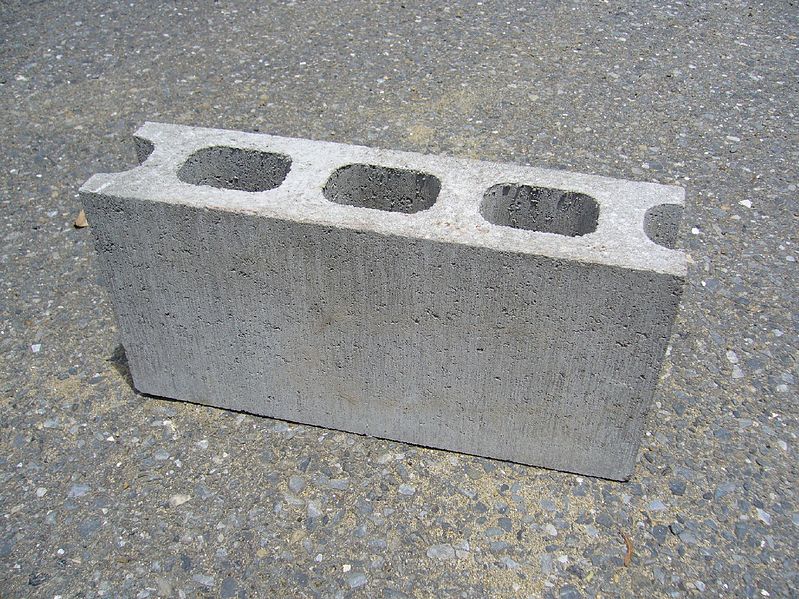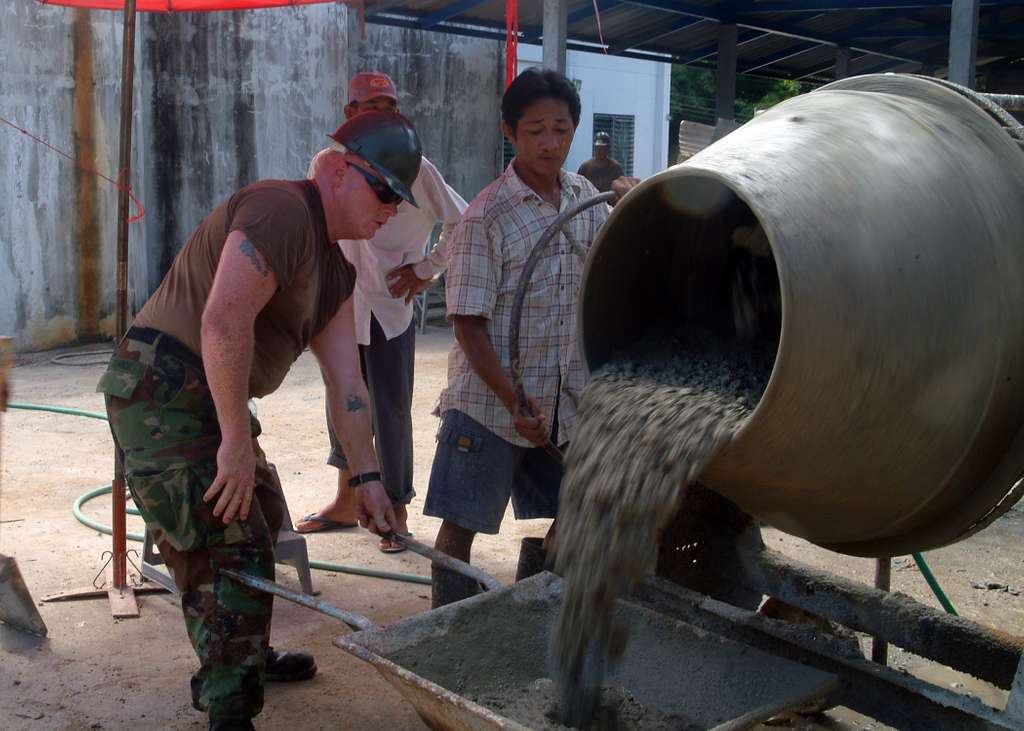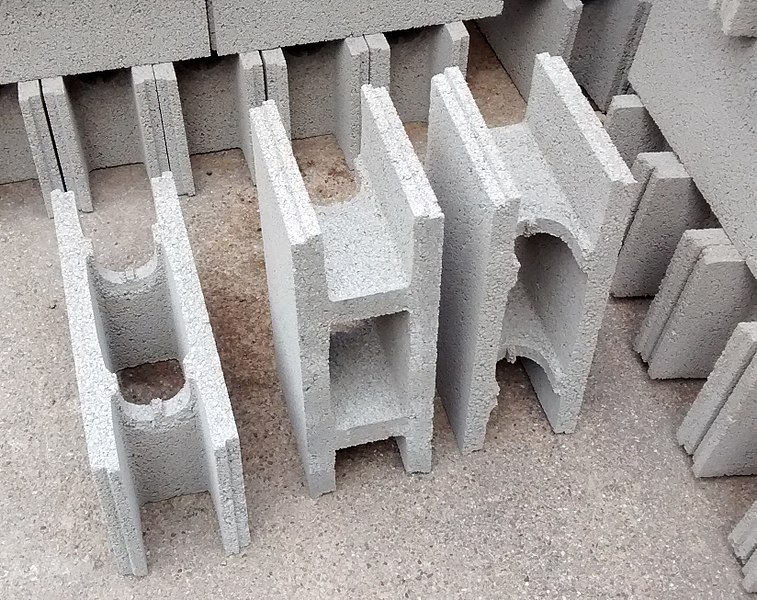You don’t need big pieces of machinery to start a business of making hollow blocks. With different kinds of mold, you can customize the form of your hollow blocks. The creation of hollow blocks depends on the time it takes to harden and the overall mixture of the cement.
Photo Courtesy: Wikimedia Commons
The other terms for hollow blocks are cement bricks or concrete blocks. Hollow blocks are popular materials in construction. Hollow blocks price is high. However, you can make your own. It is possible to make one in your own home without the use of automated machines. If you are dedicated, you can even build a successful business out of it.
Brief background of hollow blocks
Hollow blocks size and shapes are standard to ensure uniformity in construction. The block itself has room for a mortar bed. Other manufacturers offer variations with their hollow blocks to achieve visual effects. There are hollow blocks that resist water leakage through the exterior walls. There are hollow blocks with rough stone-like texture, so they appear cut and dressed stone. The first use of hollow blocks was as a substitute for stone and wood in homes. They are cheap but look as expensive as a wood-framed masonry stone house. Hollow blocks simulate stone textures like rock-faced, granite-faced, and rusticated. Hollow blocks started as “experimental” and advertised as weatherproof, vermin-proof, fireproof.
Materials for hollow blocks
Gravel, sand, water, and cement make up hollow blocks. They produce light gray blocks with high compression strength and surface texture. Replacing gravel and sand with slate, shale, and clay makes lightweight hollow blocks. Expanded slate, shale, and clay are made by crushing the raw materials and heating them to 1093 Celsius. The hollow blocks mixture also used admixtures, which are various chemicals, to improve workability, increase compression strength, and alter time.
Let’s get started with creating hollow blocks!
There are four fundamental processes in creating hollow blocks: mixing, molding, curing, and cubing. Some plants are capable of making more than 2,000 blocks per hour. Other manufacturing plants also precast concrete blocks products like flat paver stones and decorative pieces of landscaping like lawn endings.
Find a comfortable place.
The first step is to find a comfortable place where you are going to make hollow blocks. The space should be wide open. A room with shade is a good idea. The room is perfect if your place does not experience a lot of rain. The room should be big enough to pour in mold and mix concrete.
Create the mold.
Make a one-side open box with an inner cavity of 150mm (thick), 200m (width), and 300mm (length), which is the standard size for hollow blocks. Use nails and planks of plywood for this.
Prepare the mix of concrete.
The concrete mix is composed of water, cement, gravel, and sand. Have the biggest container that can fit inside your workroom. The ratio should be 1:2:3 in putting the cement, sand, and gravel in the container Pour water until the mixture of concrete is good enough to be poured into the mold. Mix the water in the bowl. Use a rod to stir the mixture continuously.
Photo Courtesy: Picryl
Create the hardened hollow block.
The mixture of concrete must be poured into the mold. Vibrate or stir the mold so that the mold and concrete settle with each other and each the extreme ends. At the open face of the mold, use a plank of plywood to scoop the excess mixture of concrete. Run the plank of plywood across the open surface to level it smooth.
Curing and cubing of hollow blocks
The hollow blocks should be for curing. The process of curing takes around two weeks to give the hollow blocks the required compression strength. The hollow block must be kept in the mold for 24 hours for drying. Then it should be put in a tank of water for curing after removing the hollow block from the mold. The hollow block will be for cubing in the final stage.
Publicity and sales
The last part is all about publicity and sales. After you have the finished product, you can create a website to promote your hollow block or make a small advertisement in the newspaper about your hollow block services.
Quality Assurance of hollow blocks
To ensure that the hollow blocks have the required properties, the blocks are monitored constantly to make sure that their manufacture follows the standards. To achieve the required strength, the cycle times, pressures, and temperatures are recorded and controlled automatically to ensure that the blocks are cured well. Before it is used, water might pass through a heater and chiller in areas with extremely harsh temperatures. The amount of water to be added to the mix is automatically adjusted to compensate and the trapped water content in the gravel and sand may be measured with ultrasonic sensors. Before they are placed in a mixer, the raw materials are electronically weighed.
Hollow blocks shape
Creators of hollow blocks must consider the ideal shape for the block. The manufacturing process must fit with the desired shape of the block. Hollow blocks with additional steps and complex mold in the process may slow down production and increase costs. The increased costs may offset the advantage of the new design and make the block too costly.
Photo Courtesy: Wikimedia Commons
Final words
Because hollow blocks price in the Philippines is already expensive, you have the option to create your own at home. However, you must consider the materials, work, and time that you are going to invest in this project. But with hard work and perseverance, you can certainly create a modest to successful hollow block business.
CITATIONS:
- “How Concrete Block Is Made – Material, Manufacture, Used, Components, Structure, Steps, Machine.” Madehow.com, 2014, www.madehow.com/Volume-3/Concrete-Block.html.
- “How to Make Concrete Blocks – Manufacturing Cement Bricks, Concrete Blocks, Hollow Cement Bricks, Cement Stock Bricks.” Brighthubengineering.com, 20 Aug. 2009, www.brighthubengineering.com/concrete-technology/46281-start-a-concrete-block-making-business-without-investing-in-machinery.
- “Making Hollow Blocks.” Livelihood Technology, 22 Oct. 2009, parispeakblog.wordpress.com/2009/10/22/making-hollow-blocks
![]()













